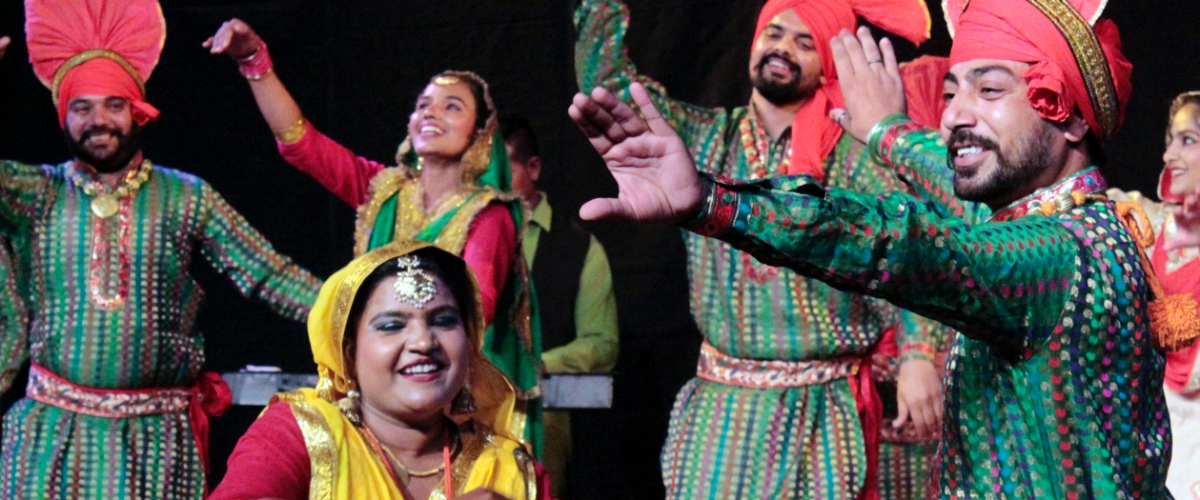

As early as 400 BC, Indian musical treatises had drawn a clear distinction between marga sangeet (music for the gods) and desi sangeet (music of people) and it is the latter that evolved into what we now know as folk music. The Indian subcontinent is a huge and diverse area with hundreds of different languages and dialects, and folk music varies greatly from region to region.
Although folk practices have suffered greatly as a result of the advent of film and subsequently pop music, it is nevertheless alive and kicking - perhaps if only because film and pop composers repeatedly look to folk for inspiration and, in so doing, brought it back to the people albeit sometimes in a synthetic form.
Folk music has also played a very large part in acting as a (partial) source for classical music with a number of raags (melodic structures) clearly derived from folk riffs. Although a large proportion of South Asia’s folk music is linked to dance, there are numerous song forms – usually identified thematically – which are designed solely for singing.
There are songs to mark every occasion – births, deaths and marriages, as well as celebratory songs related to nature’s cycles, such as the harvest, or monsoon. Additionally, every region has a substantial proportion of songs linked specifically to a devotional or spiritual tradition.
The Punjab spans the border between India and Pakistan, but for musical purposes is treated as a single region. It is the sub-continent’s largest and richest area with one of its folk genres providing a treasury from which many kinds of music have drawn inspiration: namely, the form known as bhangra. An integral part of an athletic harvest dance, bhangra (which some believe derives its name from bhang, an intoxicating cannabis-based drink) has, nevertheless, made the journey from Punjabi farms to nightclubs, concert halls and recording studios all over the world.
It is characterised by its catchy rhythms accentuated by the Punjabi folk drum known as dhol. There are numerous other, lesser-known forms of Punjabi folk music too, many dealing with spiritual themes represented as legends of ill-fated lovers like Heer-Ranjha or Sohni-Mahival.
With the Punjab having the largest share of South Asia’s most outstanding mystical poets, a great deal of its folk tradition is inextricably linked with the Sufi (Islamic mystical) tradition of Punjabi poetry - sung as kafi, a specific poetic form (not to be confused with the raag of the same name).
The north-western state of Rajasthan has an elaborate system of musical families subdivided by caste, genre, and religion, with numerous song forms unique to the region. The words mostly relate to everyday life in the desert, including tasks like fetching water from the well (known as panihari) whilst others focus on the arrival of rains – a cause for celebration in the region. In addition, its cities like Jaipur have served as important centres of patronage for the development and perfection of North Indian classical music and dance as well as instruments such as the sarangi.
The state of Maharashtra’s most famous folk-genre is known as lavani which is traditionally linked to street-theatre and usually requires performers to dance and sing at the same time. Lavani is little-known outside of India, unlike the folk music of Gujarat which remains a thriving tradition the world over.
The best known forms are garba and dandya, both inseparable from the group dances which always accompany them. Both are specifically rhythm-based but while garba involves dancers clapping, dandya (meaning ‘sticks’) actually uses sticks - one in each hand, which enhance the rhythm by being struck on the beat.
Bengal, comprising the Indian state as well as the whole of Bangladesh, is generally considered South Asia’s single most musical region, not only teeming with connoisseurs of North Indian classical music, but also famed for its Rabindrasangeet, a hybrid form utilising elements of classical as well as Bengali folk tunes, invented by world-famous poet Rabindranath Tagore. It has a distinct sound characterised by its emphasis on melody, unlike other well-known Indian folk genres such as garba and bhangra which are largely rhythm-led.
Another treasure from Bengal is a mystical folk form known as baul music which is performed by street musicians of the same name, (baula meaning ‘crazed’ in Hindi/Bengali). It is not linked to any particular religion, and the poetry of baul songs, often accompanied by instruments such as ektara (a very basic one-stringed lute) is drawn from many sources including the verses of Tagore.
A large part of the baul repertoire is classified as bhatiyali, songs of Bengal’s boatman. The area is traversed by many rivers and tributaries, and water transport in precarious home-made boats is an essential part of daily life, providing convenient metaphors for the journey of life itself. The songs are characterised by rocking, water-lapping rhythms.
Listen to the music | Parvathi Baul performs a Sufi-infused baul song in West Bengal.
Jameela Siddiqi is an author, linguist, and BBC cultural commentator, specialising in postcolonial fiction and the devotional music of South Asia.
Darbar believes in the power of Indian classical music to stir, thrill, and inspire. Explore our YouTube channel, or subscribe to the Darbar Concert Hall to watch extended festival performances, talk and documentaries in pristine HD and UHD quality.
Exploring ten strange, beautiful instruments from India's classical traditions. By George Howlett | Part of Living...
Read More 
The beginner's guide to Indian classical music. Whether you’re completely new to raga music or just need a refresher, we’ve put together this brief overview of all things raga music to help you feel at ease when visiting one of our concerts or watch our videos on our YouTube or our Darbar Concert Hall.
Keep up to date with the latest news, events, music and musings across our social channels
For hundreds more clips and shorts, vist our YT page here 